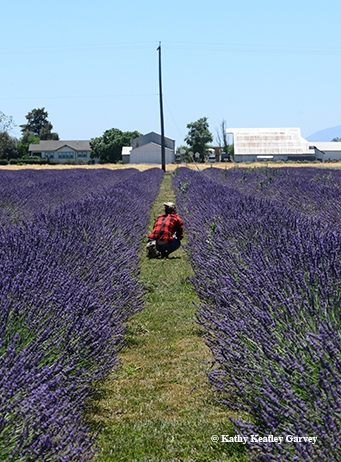- Author: Kathy Keatley Garvey
If you attended the Lavender Festival last weekend at the six-acre Araceli Farms at 7389 Pitt School Road, Dixon, you were in for a real treat.
Planted in April 2017, the fields glowed with seven varieties of lavender: Grosso, Provence, White Spike, Royal Velvet, Violet Intrigue, Folgate, and Melissa.
This is a family-owned business: parents Robert and Araceli and daughter Justina grow pesticide-free lavender and produce handmade, all natural products. They also host lavender festivals, lavender U-Pick, events, and workshops. (See the family's website and Facebook page.)
Last Saturday the lavender fields buzzed with honey bees from "Clay's Bees," belonging to Clay Ford, who owns the Pleasants Valley Honey Company. He and his wife, Karen, sell their honey at Farmers' Markets in Vacaville and Fairfield and other venues. Soon they'll be adding lavender honey.
But back to the fields: visitors delighted in wreathing lavender around their heads and necks, purchasing lavender products, and photographing one another in the fields. They came with tripods, professional cameras, and cell phones. But most of all, with smiles!
A day in the country with rows and rows of aromatic lavender definitely yields lots of smiles, joy and laughter.
Virtually unnoticed were the insects: Cordovan honey bees, the color of pure gold, rushed to gather the pollen and nectar, as if they knew the fields would be harvested Monday, June 24. We spotted a few yellow-faced bumble bees (Bombus vosnesenskii), cabbage white butterflies (Pieris rapae), and scores of migratory painted ladies (Vanessa cardui). "This is the second post-desert generation (Vanessa cardui), so altogether three generations have been involved," butterfly guru Art Shapiro, UC Davis distinguished professor of evolution and ecology, told us Sunday, June 23. "The flight began here March 17--so today is the 98th day!"

Visitors browsed the vendor booths, all offering products or information. Drawing bee enthusiasts was Tora Rocha of the Pollinator Posse, a Bay Area-based organization that she and Terry Smith founded in Oakland in 2013 to create pollinator-friendly landscaping in urban settings and to foster appreciation of local ecosystems through outreach, education and direct action. Rocha, a retired Oakland parks supervisor, says that eco-friendly landscape techniques are at the heart of their work. They envision a day "when life-enhancing, thought-inspiring green spaces will grace every corner of the city and the world beyond." And spaces filled with bee condos for native bees! They make and sell AirBeeNBees for leafcutter bees and mason bees. (Check out their Facebook page.)

The owners of Araceli Farms love being lavender farmers. "Like anything in life, there wasn't a linear path to this," Justina relates on her blog. "Looking back on it now, I see how I was being prepped for this role, but I had no idea. After college, I landed a highly-sought after job with tons of prestige; it was incredible and I was so excited, but after some time I knew it wasn't my future. It didn't spark passion nor fuel my envisioned."
The lavender farm does.
One of the Araceli Farms employees, Maria Gonzalez of Dixon, sporting a curved harvesting knife, a wide-brimmed hat and an even wider smile, said she's been working the fields for two years.
And lovin' the lavender.
It's easy to love.
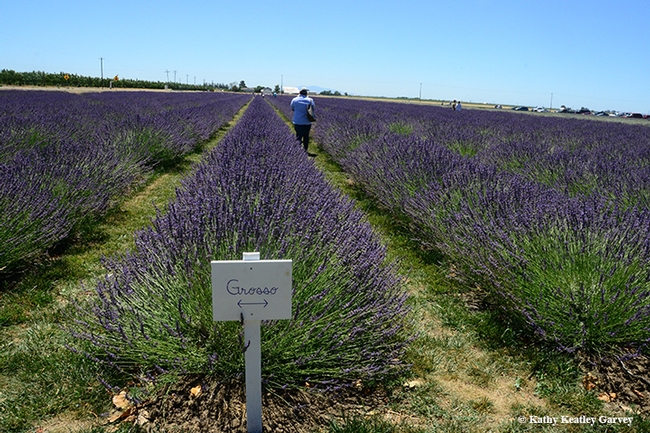

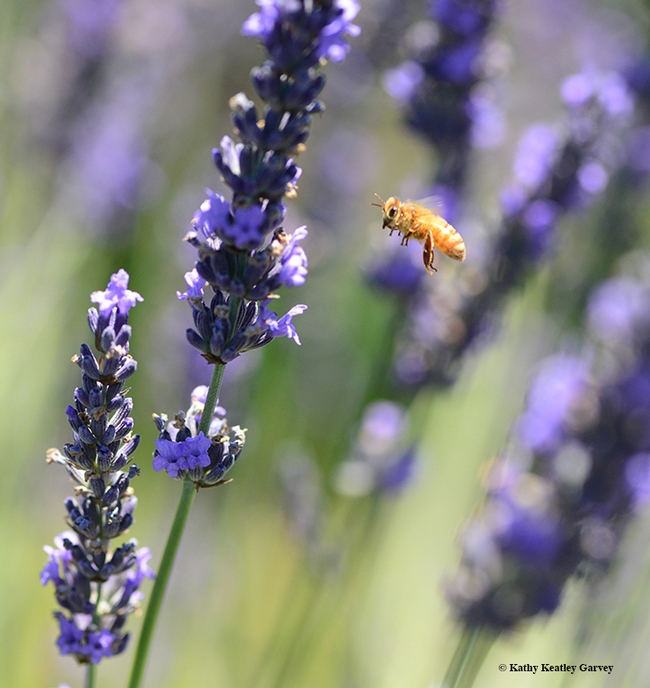
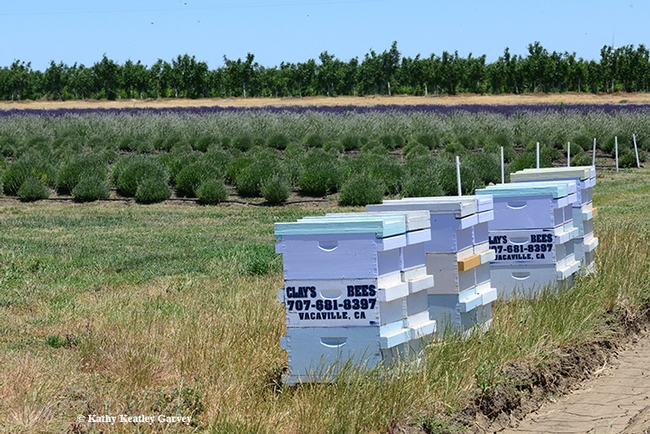
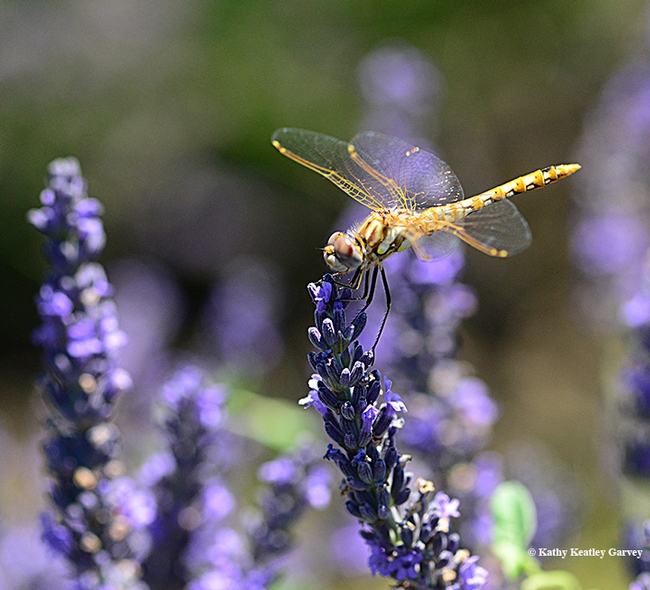

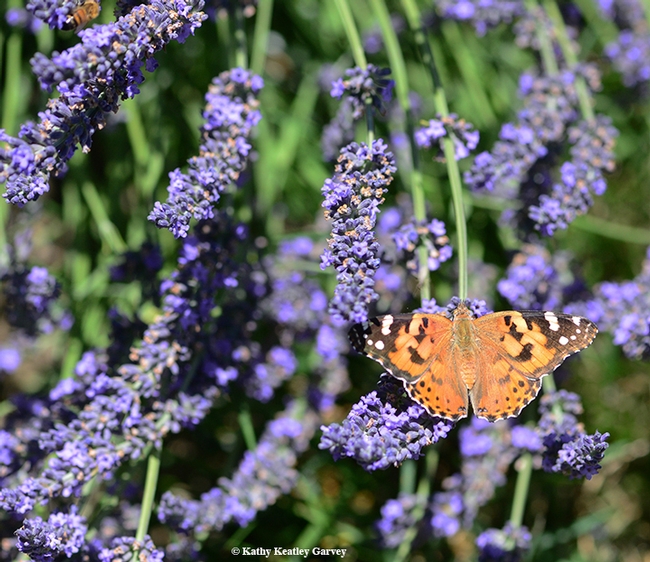
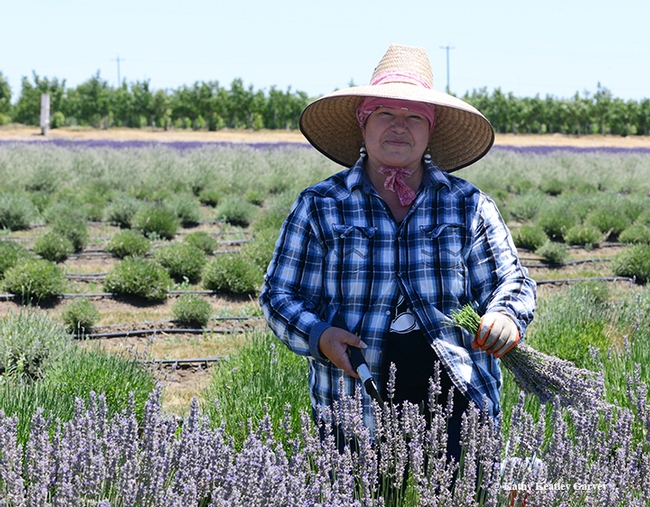
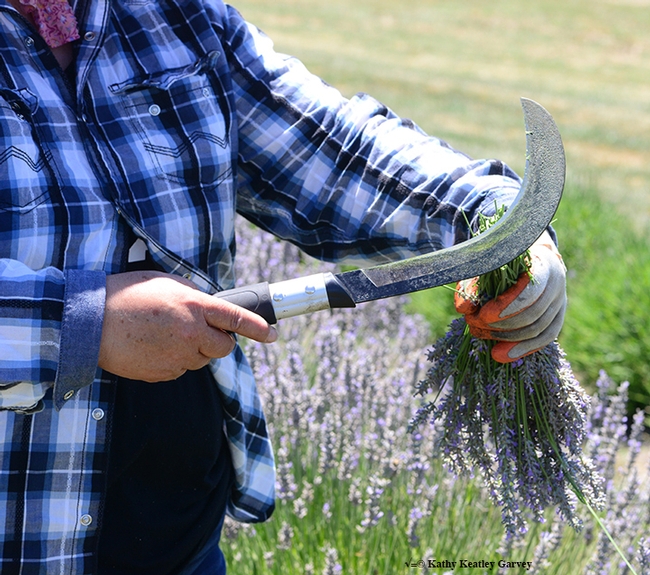

- Author: Kathy Keatley Garvey
In between the rains today, we saw them.
So beautiful! Painted ladies, Vanessa cardui, nectaring in patches of colorful wildflowers in the Biological Orchard and Gardens (BOG), located behind the Mann Laboratory on University of California, Davis campus.
The migratory butterflies, passing through California on their way to the Pacific Northwest, stopped there for some flight fuel: sipping nectar from tidy tips, Layia platyglossa; five-spot, Nemophila maculate, and blue lupine, Lupinus.
They've been in the national news a lot, these butterflies, as has butterfly guru Art Shapiro, UC Davis distinguished professor of evolution and ecology. Known for his expertise on all things butterfly, he's monitored the butterfly population of Central California since 1972 and maintains a research website.
Yes, it's been a big year for painted ladies, thanks to the heavy rainfall and super blooms in the deserts near the Mexican border. And, as Shapiro says, tremendous wildflower blooms are typically great years for the painted ladies.
New York Times reporter Julia Jacobs interviewed Shapiro for her March 17th piece, in which she marveled that millions of the painted ladies are migrating. Shapiro told her: "The striking thing is they're moving very rapidly and directionallly. So it's almost like being in a hail of bullets.”
Rita LeRoy or "Farmer Rita," the self-described "Farm Keeper" on the Loma Vista Farm, Vallejo, part of the Vallejo City Unified School District, saw the butterflies passing through the farm on Monday, March 17. Her description is fabulous:
"They came through Vallejo on Monday," she said. "Art's description was right on. It was like being in a hail of bullets. This was because they were flying so low and it was a constant stream, like standing in the middle of a 500 lane expressway. I kept telling the students, 'Look! Another, another, another...' The path was at least as wide as the farm which is about 200 yards. When I stood in one spot, I would agree they were passing within my vision (about 100') at about 1 every second. They rarely stopped to nectar but were flying in a very direct NE direction when they came through the farm. They flew through nonstop from before 1 p.m. and the flow started to dwindle around 4 p.m. Still enough at that point to show the after school kids. They didn't fly in huddled groups or clouds and they moved fast. I tried taking a video but it was like a bad remake of The Blair Witch Project, with unfocused, whiplash camera moves of uncertain objects since they are so small in the overall background. I'm so glad Art saw them."
Today (Wednesday) we didn't see the hail of bullets, but we did see about a dozen of them grabbing some flight fuel on the UC Davis campus over a 10-minute period.
If you get a chance, check out the Biological Orchard and Gardens. A 24,000-square-foot garden, located behind the Mann lab, off Kleiber Hall Drive, it's planted with several dozen species of heritage fruit trees, and landscaped with flower gardens. The painted ladies are elsewhere on campus, too, including the UC Davis Arboretum and Public Garden.
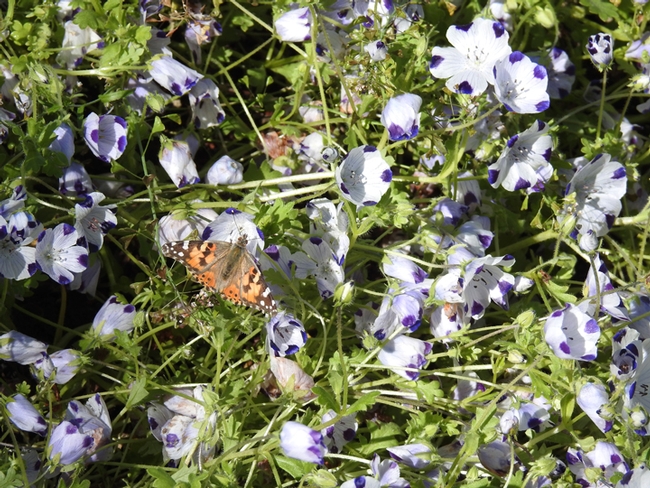
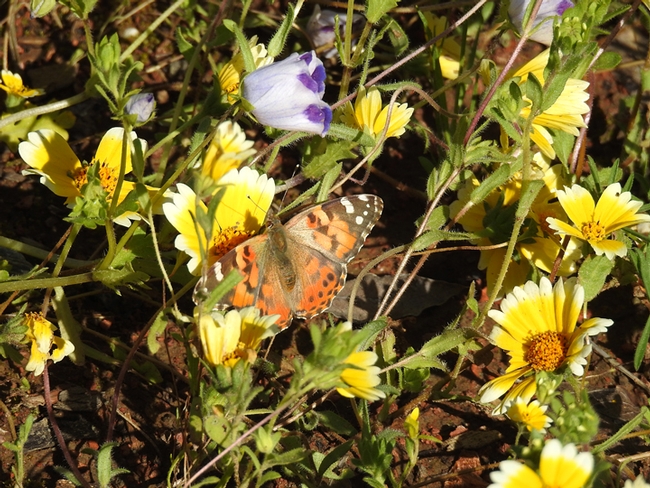

- Author: Kathy Keatley Garvey
The painted ladies are on the move.
Have you seen these migratory butterflies, Vanessa cardui, passing through California on their way to the Pacific Northwest?
Me? No! Zero. Zilch. Zip.
But butterfly guru Art Shapiro, distinguished professor of evolution and ecology, who has monitored the butterfly population of Central California for more than four decades and maintains a research website, has seen approximately 400 painted ladies this season--about 300 today.
All I saw today was a lone cabbage white butterfly flying through our pollinator garden in Vacaville.
Guess the painted ladies didn't get the message. The New York Times, did, though.
"The orange butterflies, called painted ladies, are known to travel annually from the deserts of Southern California to the Pacific Northwest," wrote New York Times reporter Julia Jacobs in a March 17th piece. "This month, people are taking notice because of the sheer size of the migration: Scientists estimate the teeming painted ladies number in the millions."
"Substantial rainfall in the deserts near the Mexican border, where the North American painted ladies lay their eggs, is the reason for the unusually large swarms," Jacobs pointed out. "The rain caused plants to thrive, giving the painted lady caterpillars plenty of food to fuel their transformation, said Art Shapiro, a professor of evolution and ecology at the University of California, Davis."
Shapiro told the New York Times that "the striking thing is they're moving very rapidly and directionally. So it's almost like being in a hail of bullets.”
They're passing through Davis, too. Shapiro headed over to the UC Davis Memorial Union patio today and noticed that "the painted ladies are on the upswing. Many are nectaring, suggesting they're running out of fat, but despite the abundance of potential hosts, saw no oviposiiton. Condition extremely variable, from beat-to-hell to looking almost fresh."
The professor witnessed them passing by the Memorial Union "roughly one every 90 seconds." Ironically, no one seemed to notice them, Shapiro said. Well, it is finals week!
The Los Angeles Times reported March 11 that a "massive swarm of at least 1 billion butterflies is traveling across Los Angeles and neighboring counties at a breathtaking speed of almost 20 miles an hour." They're in a "rush to reach their breeding areas in Oregon."
Shapiro says that years of tremendous wildflower blooms are typically big years for the butterflies. The last big year was 2005. He explains the phenonomen on his website:
"This mass-migrant occurs in much of the Northern Hemisphere. Apparently the entire North American population winters near the US-Mexico border, breeding in the desert after the winter rains generate a crop of annual Malvaceous, Boraginaceous and Asteraceous hosts. The resulting butterflies migrate north. In good years (lots of desert rain) they may do so by billions, interfering with traffic and attracting the attention of the media. 2005 was one of the biggest Painted Lady years in history--perhaps the biggest, but how can we know? At Sacramento at the height of the migration butterflies were passing in one's field of vision at the rate of about 3 per second! 2006, by contrast, was a La Nina year with very little rain in the desert. The butterflies apparently gave up trying to breed there and flew north in February. They tried to breed but mostly were unsuccessful due to bad weather, resulting in only very sporadic individual sightings of their progeny in May.
"Northward-migrating Painted Ladies are provisioned with yellow fat and are reproductively immature," he writes. "They do not stop to feed or have sex until they have burned up their reserves, carried over from the caterpillar stage. They fly in a straight line from SE to NW, like 'bats out of Hell,' and go over obstacles rather than trying to go around them. (On certain days there may be concerted local movements in the wrong direction. We do not understand these.) Painted Ladies tend to fly parallel to the Sierra Nevada, not across it. They enter the Central Valley through the Inyo-Kern lowland or by crossing the Transverse Ranges. They can apparently make it from Bishop to Davis in three days. In some years the migration is heavier in the Great Basin and on the East slope of the Sierra than farther west.
"The Painted Lady moves northward in a generational wave as the season progresses. Frequently it disappears altogether from the lowlands in summer. Beginning in August the movement reverses and butterflies head south toward the desert wintering grounds. The southward migration is a more protracted affair, with plenty of adult feeding and some breeding en route. Numbers tend to be highest east of the crest, on Rabbitbrush blossoms in October."
Well, maybe tomorrow one or more painted ladies will fly my way. Preferably more.
Shapiro just received word of "a major movement through the Kern River Valley. Inyo-Kern is the superhighway from the desert to the Central Valley, so the biggest numbers may yet be on the way."
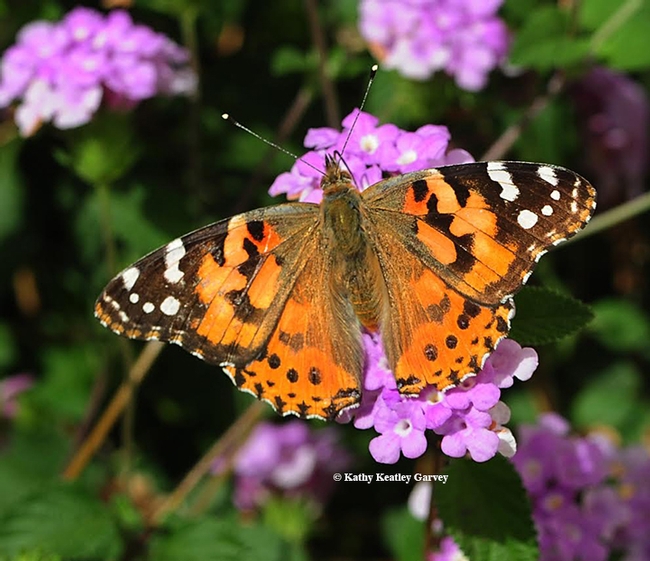
- Author: Kathy Keatley Garvey
Who knew?
You've probably watched those colorful painted ladies (Vanessa cardui) fluttering about in your yard, but have you read the newly published research about their wing color patterns and genetic codes?
In researching the color patterns and the genes responsible for those patterns, biologists Jeffrey Marcus and Roohollah Abbasi of the University of Manitoba, Winnipeg, Canada, found a previously undetected compartment boundary that may exist in all holometabolous insects. (Holometabolism, also called complete metamorphism, is a form of insect development that includes four stages: egg, larva, pupa and adult.)
Scientists have long known that in the common fruit fly, Drosophila melanogaster, the forewing is divided into two developmental compartments, but this newly published research in Scientific Reports, A New A-P Compartment Boundary and Organizer in Holometabolous Insect Wings, is a real eye-opener.
Writer Viviane Callier of Washington, D.C., a trained insect physiologist, wrote about the research in the Nov. 30th edition of Entomology Today, published by the Entomological Society of America.
In her piece, "Butterfly Color Patterns Reveal Clues About the Genes that Build Insect Wings," Callier described butterfly wings as "natural canvases decorated with elaborate color patterns," but noted that "how these patterns develop and evolve is still incompletely understood. Now, a new study in Scientific Reports (Nature.com) has identified the genetic code by which butterflies can assign color patterns to different parts of their wings during development. The code is based on a set of genes called transcription factors that establish compartments in most—perhaps all—insect wings. Each compartment, whose 'address' is determined by the combination of genes that are active in that sector of the wing, can evolve different color patterns independently from the other compartments."
Marcus and Abbasi explained in their abstract:
"Decades of research on the highly modified wings of Drosophila melanogaster has suggested that insect wings are divided into two Anterior-Posterior (A-P) compartments separated by an axis of symmetry. This axis of symmetry is created by a developmental organizer that establishes symmetrical patterns of gene expression that in turn pattern the A-P axis of the wing. Butterflies possess more typical insect wings and butterfly wing colour patterns provide many landmarks for studies of wing structure and development. Using eyespot colour pattern variation in Vanessa butterflies, here we show an additional A-P axis of symmetry running between wing sectors 3 and 4. Boundaries of Drosophila mitotic clones suggest the existence of a previously undetected Far-Posterior (F-P) compartment boundary that coincides with this additional A-P axis. A similar compartment boundary is evident in butterfly mosaic gynandromorphs. We suggest that this additional compartment boundary and its associated developmental organizer create an axis of wing colour pattern symmetry and a gene expression-based combinatorial code, permitting each insect wing compartment to acquire a unique identity and allowing for the individuation of butterfly eyespots."
The research "bears on some of our T-shock experiments back in the 70s-80s," observed Art Shapiro, distinguished professor of evolution and ecology when asked if he'd read the research paper. Yes. He wrote a chapter, The Genetics of Seasonal Polyphenism and the Evolution of 'General Purpose Genotypes' in Butterflies' in the Klaus Wöhrmann/Volker Loeschcke book, Population Biology and Evolution. You can read it online.
In his abstract, Shapiro, who has studied and monitored butterflies for more than four decades and maintains a website, Art's Butterfly World, points out that his Genetics of Seasonal Polyphenism chapter "is really a specialized appendix to Professor Scharloo's on 'The Genetics of Adaptive Reactions.' It deals with a particular set of such reactions — those of butterfly wing patterns to environmental factors — and asks whether those which seem adaptive are evolutionarily related to those which do not, and if so, how. Despite more than a century of interest in such phenomena, the answers are not yet in; we are only now able to do the carefully controlled experiments necessary to partition phenotypic variation into its environmental and genetic components and this work is still very much in progress. So this will be a very unsatisfying presentation — full of qualitative statements, long on speculation, short on hard data. If it serves as a provocation it will have done its duty."
Shapiro goes on to say that "a glance through any butterfly book of the coffee table variety reveals an astonishing diversity of patterns. The fact is that we have only the remotest idea of the functional significance of any of them, as we were recently reminded by Silberglied et al. (1980). One reason is that bewildering diversity which defies rational classification; another is that it is almost impossible to relate a pattern to an ecological and behavioral context when observing a specimen set on a pin."
All the more reason to marvel at the stunning diversity of butterflies that grace our yards. Or what Viviane Callier so eloquently described as "natural canvases decorated with elaborate color patterns."
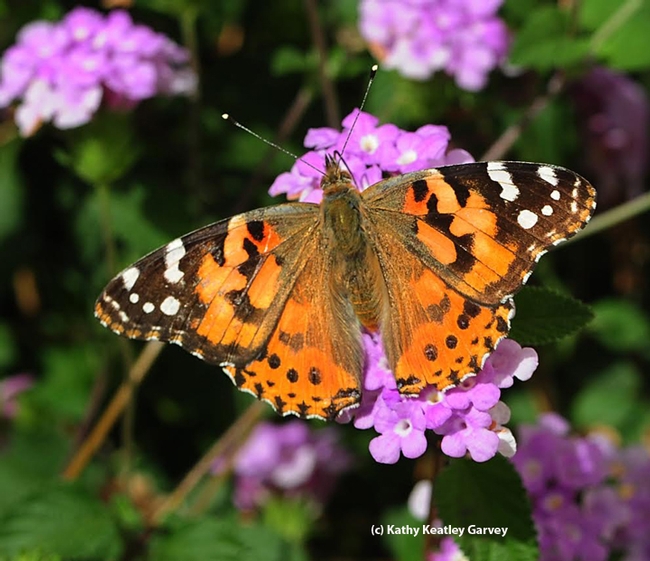
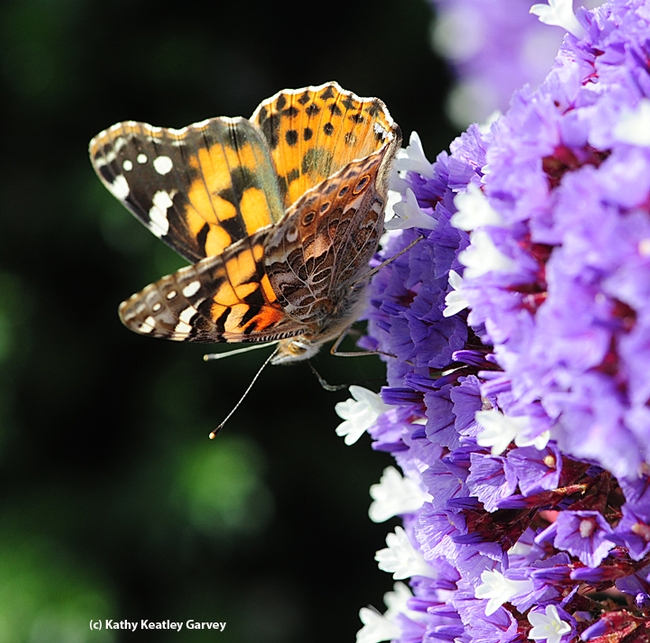
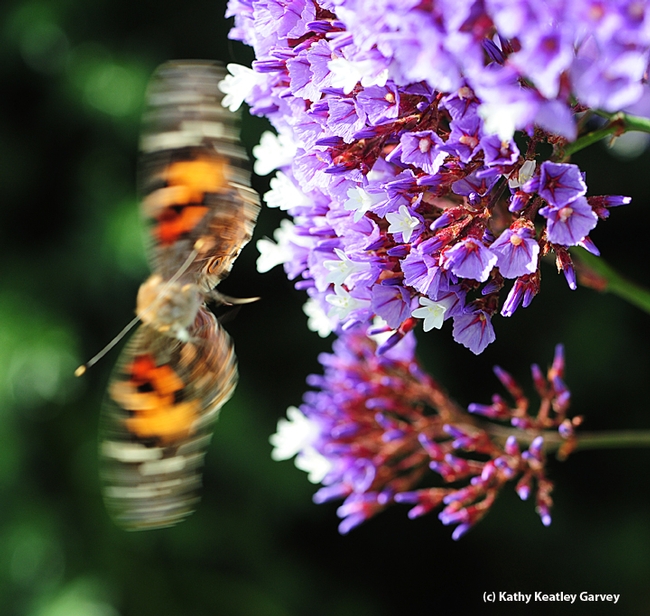
- Author: Kathy Keatley Garvey
The painted ladies are back.
No, not the Victorian and Edwardian homes painted in three colors. No, not women wearing excessive amounts of makeup and pounding the sidewalk with their stiletto heels.
These are BUTTERFLIES.
"Another Painted Lady (Vanessa cardui) migration is occurring in north-central
Why hints of overwintering and breeding? Because the insects "were in good condition and did not appear to have migrated long distances," Shapiro says. "They also did not show the usual color-and-pattern signs of having been generated in the desert, but they were not produced locally in the Davis-Sacramento region and were seemingly confined to the west side of the Valley."
Shapiro reports that the
We saw them last weekend passing through parts of Solano and Yolo counties. They were moving fast and flying low.
"These butterflies are powered by yellow fat carried over from the caterpillar stage and fly like 'bats out of hell' from the Southeast to the Northwest a few feet off the ground, not stopping for food or sex until their fat reserves become depleted," Shaparo. He spotted a few feeding and one female was laying eggs.
Shapiro is updating the migration on the home page of his Web site. It's a must-read. You can learn more about Painted Ladies inside his Web site. See also pages 48-51 and 195-200 of his Field Guide to Butterflies of the San Francisco Bay and Sacramento Valley Regions (
Got a migration report or a video to offer him for his Web site? You can email him at amshapiro@ucdavis.edu.
Meanwhile, those Painted Ladies are absolutely gorgeous. We've heard far too much about ballistic bailouts, burgeoning bonuses and mortage meltdowns--and not enough about the Painted Ladies.
Bring 'em on!


